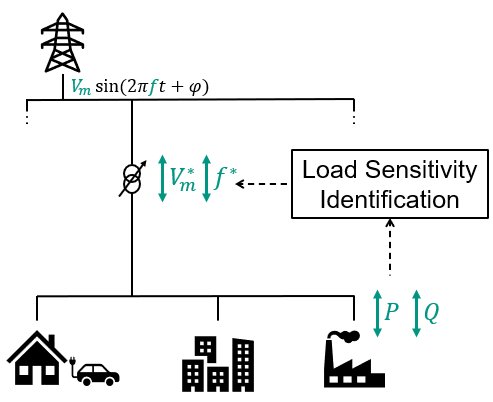Load Parameters Identification and Control
Many countries all over the world have ambitious plans for neutral-emission electric networks. Therefore, the penetration of renewable energy resources is increasing swiftly. This change in the modern power system brings new challenges and requirements for system control, as renewables are often less controllable.
It is already possible to adjust the voltage level of a grid part thanks to tap-changers connected to conventional transformers. This idea can be extended to small voltage tuning, or even frequency regulation, as the energy system moves towards a high penetration of electronic-based devices. Especially the Solid State Transformer is of interest to the scientific community.
However, the system lacks real-time and accurate parameters, such as load parameters, which would allow more precise control actions and support the grid. In particular, the so-called load sensitivity, which represents the percentage of power change of a load, when a change in nominal voltage or frequency occurs, is a valuable information for the grid.
Therefore, our work seeks to extract power flexibility from the distribution grid or the demand side to support the mains.
Our work

for demand-side management
Load sensitivity quantifies the change in load power consumption under voltage or frequency variations. Knowing the load sensitivity value, the load power can be shaped by varying the voltage and frequency using power electronic-based interfaces such as solid-state transformers (SSTs).
Our work focuses on creating a controller that is able to shape the voltage and frequency using the information provided by a load parameters calculation tool. Different load sensitivity identification algorithms are implemented and compared in terms of accuracy and computational load. The use of such a calculation tool also requires measurement capabilities of voltage, frequency, and active and reactive power, which are the input quantities needed for parameter identification.
Application in a PHIL environment
At the Energy Smart Home Lab (ESHL), located at the campus south of the Karlsruhe Institute of Technology, we are also able to test our control and identification algorithm with real household appliances. The ESHL is connected to a 4-quadrant voltage amplifier that supplies the house with our simulated grid. This allows us to simulate voltage or frequency disturbances and evaluate the impact on the power consumption of the loads. It is then possible to measure the electrical parameters of the entire house or of a single load, which enable us to study its sensitivity to a voltage or a frequency change, as well as to study the potential of such a control in our real electrical grid.

